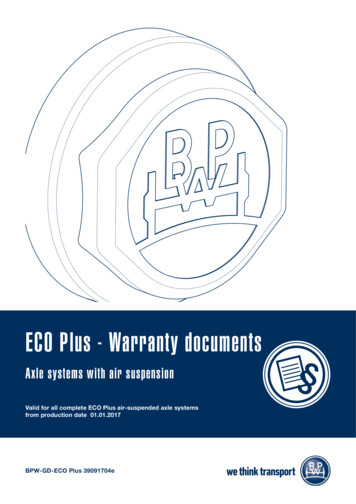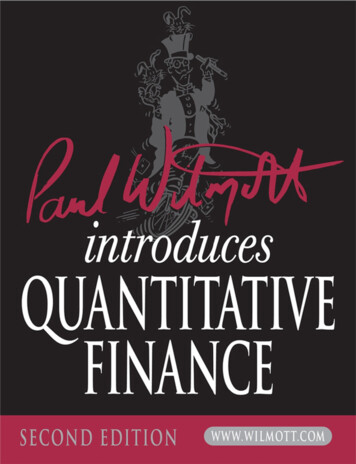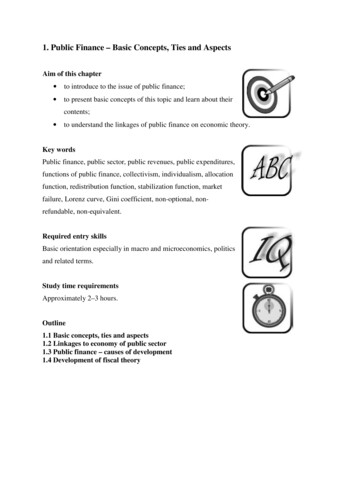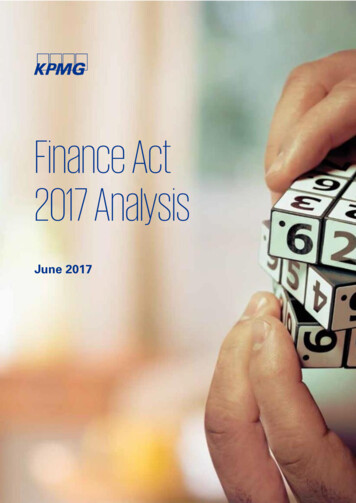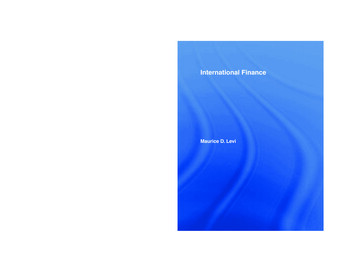
Transcription
991.qxd7/15/200611:41 AMPage 1Batch number: 1CIRCULATEDDate:SEEN BY DESK EDITOR: REVISE NEEDEDInitial:Date:APPROVED FOR PRESS BY DESK EDITORInitial:Date:Back board: ISBN BarcodeFourtheditionINTERNATIONAL FINANCEMaurice D. LeviCHECKLIST (must be completed before press)(Please cross through any items that are not applicable)Front board:Spine: Title Title Subtitle Subtitle Author/edited by Author/edited by Series title Extra logo if required Extra logo if requiredGeneral: Book size Type fit on spineInternational FinanceMaurice D. LeviISBN 978-0-415-30899-1,!7IA4Bwww.routledge.com ï an informa businessPC4RoyalDemyB-formatSpine back edge
International FinanceFourth editionIn today’s global economy, the international business community requires a thorough knowledge and understandingof the complexities of international finance.In this fourth edition, Maurice D. Levi successfully integrates both the micro and macro aspects of internationalfinance. The author explores managerial issues and focuses on problems that arise from financial trading relationsbetween nations, while covering key topics such as:“““““organization of foreign exchange markets,determination of exchange rates,the fundamental principles of international finance,foreign exchange risk and exposure,fixed and flexible exchange rates.This impressive new edition builds and improves upon the popular style and structure of the original. With new data,improved pedagogy, and coverage of all of the main developments in international finance over the last few years,this book will prove essential reading for economics and business students.Maurice D. Levi has 30 years of teaching experience in the area of international finance.
InternationalFinanceFourth editionMaurice D. Levi
First published 2005by Routledge2 Park Square, Milton Park, Abingdon, Oxon OX14 4RNSimultaneously published in the USA and Canadaby Routledge270 Madison Avenue, New York, NY 10016Routledge is an imprint of the Taylor & Francis Group# 2005 Maurice D. LeviTypeset in Perpetua and Bell Gothic by Newgen Imaging Systems (P) Ltd, Chennai, IndiaPrinted and bound in Great Britain by Bell & Bain Ltd, GlasgowAll rights reserved. No part of this book may be reprinted or reproduced or utilised in any form or by anyelectronic, mechanical, or other means, now known or hereafter invented, including photocopying and recording,or in any information storage or retrieval system, without permission in writing from the publishers.British Library Cataloguing in Publication DataA catalogue record for this book is available from the British LibraryLibrary of Congress Cataloging in Publication DataA catalog record for this book has been requestedISBN 0–415–30899–2 (hbk)ISBN 0–415–30900–X (pbk)
To Kate‘‘As for foreign exchange, it is almost as romantic as young love, and quiteas resistant to formulae.’’H.L. Mencken(As you shall see, it is not entirely resistant to formulae!)
About the authorSince receiving his PhD from the University of Chicago, Maurice D. Levi has taught and written researchpapers in a wide variety of areas of finance and economics. This broad range of research and teaching interests form the foundation for this book in international finance, a subject that he believes to be best treatedas an application of financial and economic principles, rather than as a separate and isolated subject area.Professor Levi has published research papers on financial market anomalies, the effectiveness ofmonetary and fiscal policy, the relationship between inflation and interest rates, the effect of taxes oninternational capital flows, and the link between inflationary expectations and unemployment, as well as inthe numerous areas of international finance that are reflected in this book. He has also written in the areas ofeconometric methods, macroeconomics, labor economics, environmental economics, money and banking,and regional economics. His papers have appeared in just about every leading research journal in financeand economics including: American Economic Review; Econometrica; Journal of Political Economy; Journal ofFinance; Journal of Monetary Economics; Journal of Money, Credit and Banking; Journal of International Money andFinance; Journal of International Economics; Management Science; Ecological Economics, and Journal of Econometrics.He is also the author of Economics and the Modern World (Heath, Lexington MA, 1994), Economics Deciphered:A Layman’s Survival Guide (Basic Books, New York, 1981), and Thinking Economically (Basic Books,New York, 1985) and the coauthor, with M. Kupferman, of Slowth (Wiley, New York, 1980).Since joining the Sauder School of Business of the University of British Columbia, Professor Levi has heldvisiting positions at the Hebrew University of Jerusalem, the University of California, Berkeley, MIT,the National Bureau of Economic Research, the University of Exeter, University of New South Wales, andthe London Business School. He has received numerous academic prizes and awards including Killam andNomura Fellowships and the Bronfman Award.
ContentsList of illustrationsPreface1 THE WORLD OF INTERNATIONAL FINANCEUnique dimensions of international financeThe benefits of studying international financeThe growing importance of international financeTopics covered in this bookSummaryReview questionsAssignment problemsBibliographyParallel material for case coursesAppendix AAppendix Bxiiixviii11121317171818191922PART ITHE MARKETS FOR FOREIGN EXCHANGE2 AN INTRODUCTION TO EXCHANGE RATESThe foreign bank note marketThe spot foreign exchange marketOrganization of the interbank spot marketDirect versus indirect exchange and cross exchange ratesSummaryReview questionsAssignment problemsBibliography3 FORWARD EXCHANGEWhat is forward foreign exchange?Forward exchange premiums and discountsForward rates versus expected future spot ratesPayoff profiles on forward exchangeOutright forward exchange and swaps27292932324350515152535354565658vii &
CONTENTSThe flexibility of forward exchangeForward quotationsSummaryReview questionsAssignment problemsBibliography4 CURRENCY FUTURES AND OPTIONS MARKETSCurrency futuresCurrency optionsForwards, futures, and options compared: a summarySummaryReview questionsAssignment problemsBibliographyAppendix A606165666667686875858687888989PART IITHE DETERMINATION OF EXCHANGE RATES5 THE BALANCE OF PAYMENTSInfluences on currency supply and demandPrinciples of balance-of-payments accountingBalance-of-payments entries and the factors that influence themImplications of the balance-of-payments accounting identityThe net international investment positionObjectives of economic policySummaryReview questionsAssignment problemsBibliography6 SUPPLY-AND-DEMAND VIEW OF EXCHANGE RATESImports, exports, and exchange ratesThe factors affecting exchange ratesThe stability of exchange ratesShort-run versus long-run trade elasticities and the J curveSummaryReview questionsAssignment problemsBibliographyAppendix 136136137137PART IIITHE FUNDAMENTAL INTERNATIONAL PARITY CONDITIONS1417 THE PURCHASING-POWER-PARITY PRINCIPLE143The law of one priceAbsolute (or static) form of the PPP conditionThe relative (or dynamic) form of PPP143144145& viii
CONTENTSEfficient markets (or speculative) form of PPPThe empirical evidence on PPPReasons for departures from PPPStatistical problems of evaluating PPPThe practical importance of PPPSummaryReview questionsAssignment problemsBibliography8 INTEREST PARITYThe investment and borrowing criteriaThe covered interest-parity conditionCombining PPP and interest parityWhy covered interest differences persistSummaryReview questionsAssignment 160166169171184185186187PART IVMANAGING FOREIGN EXCHANGE RISK AND EXPOSURE9 FOREIGN EXCHANGE EXPOSURE AND RISKThe importance of understanding risk and exposure and measuring themThe nature of exchange-rate risk and exposureExamples of foreign exchange exposureExposure as a regression slopeDefinition of foreign exchange riskExposure, risk, and the parity relationshipsSummaryReview questionsAssignment 1213213214ACCOUNTING EXPOSURE VERSUS REAL EXPOSURE216Accounting principlesReal changes in exchange ratesSummaryReview questionsAssignment problemsBibliography216220226227227228OPERATING EXPOSURE230Operations affected by exchange ratesThe exporterThe importerSummary of effects of exchange rates on exporters and importersEffect of currency of invoicing and forward hedgingMeasuring exposure: an alternative approachSummary230231240244244249251ix &
CONTENTSReview questionsAssignment problemsBibliography1213252253254HEDGING RISK AND EXPOSURE256Whether to hedge: managerial hedging versus shareholder hedgingHedging of receivables and payablesThe cost of forward hedgingThe benefit of forward hedgingFinancial engineering: payoff profiles of different hedging techniquesHaving a company hedging policySummaryReview questionsAssignment EXCHANGE-RATE FORECASTING AND SPECULATION280SpeculationMarket efficiencyExchange-rate forecastingSummaryReview questionsAssignment problemsBibliography280283288300302302303PART VINTERNATIONAL INVESTMENT AND FINANCING141516305CASH MANAGEMENT307The objectives of cash managementInvestment and borrowing choices with transaction costsInternational dimensions of cash managementSummaryReview questionsAssignment problemsBibliography307308310319320320321PORTFOLIO INVESTMENT322The benefits of international portfolio investmentInternational capital asset pricingBonds and international portfolio diversificationSettlements of international portfolio investmentsSummaryReview questionsAssignment L BUDGETING FOR FOREIGN INVESTMENTS346Selecting projectsDifficulties in evaluating foreign projects346348&x
CONTENTSCash flows: home versus foreign perspectivesDiscount rates: corporate versus shareholder perspectivesThe adjusted-present-value techniqueSelecting the appropriate discount ratesAn exampleActual practice of capital budgetingSummaryReview questionsAssignment problemsBibliographyAppendix AThe different forms of taxesOrganizational structures for reducing taxesAppendix B1718349351351354356360361362362363364364367369THE GROWTH AND CONCERNS ABOUT MULTINATIONALS373The growth of MNCsSpecial issues facing MNCs: transfer pricingSpecial issues facing MNCs: country riskProblems and benefits from the growth of MNCsTransnational alliancesSummaryReview questionsAssignment ERNATIONAL DIMENSIONS OF LONG-TERM FINANCING397Equity financingBond financingBank financing, direct loans, and the likeGovernment and development-bank lendingOther factors affecting the financing of subsidiariesFinancial structureSummaryReview questionsAssignment PART VIINSTITUTIONAL STRUCTURE OF INTERNATIONAL TRADE AND FINANCE1920421MULTINATIONAL BANKING423The Eurodollar and offshore currency marketsMultinational bankingSummaryReview questionsAssignment problemsBibliography423431441442442443INSTRUMENTS AND INSTITUTIONS OF INTERNATIONAL TRADE445Extra dimensions of international tradeInternational trade involving letters of credit: an overview of a typical transaction445445xi &
CONTENTSAlternative payment and guaranteeing proceduresThe financing of international tradeCountertradeThe institutions regulating international tradeSummaryReview questionsAssignment problemsBibliography450452456459463464464465PART VIITHE INTERNATIONAL MACROECONOMIC ENVIRONMENT: THEORIESAND PRACTICES212223467ASSET-BASED THEORIES OF EXCHANGE RATES469Stock versus flow theories of exchange ratesThe monetary theory of exchange ratesThe asset approach to exchange ratesThe portfolio-balance approach to exchange ratesTheories of exchange-rate volatilitySummaryReview questionsAssignment ERNATIVE SYSTEMS OF EXCHANGE RATES487The classical gold-standard systemThe Bretton Woods and dollar standardsThe European monetary system (EMS)Hybrid systems of exchange ratesTarget zonesSummaryReview questionsAssignment problemsBibliographyAppendix AAppendix B488491496499502504506506507508511THE INTERNATIONAL FINANCIAL SYSTEM: PAST, PRESENT, AND FUTURE514The pastThe presentThe futureDegree of exchange-rate flexibility: fixed versus flexible exchange ratesSummaryReview questionsAssignment ryName indexSubject index& xii547573578
.13.24.14.24.34.44.54A.1Percentage of GDP arising from exportsInternational investment position of the United StatesThe gain from the better allocation of capitalUtility from different consumption patternsDaily turnover in the US foreign exchange market, 1986–2001Organization of the foreign exchange marketInterbank spot and selected forward exchange ratesDirect versus indirect exchange: zero transaction costsDirect versus indirect exchange: nonzero transaction costsPayoff profile on forward contract to buy 1 millionPayoff profile on forward contract to sell 1 millionPrices of principal CME currency futures: September 18, 2003Payoff profile for purchase of euro futures contractPremiums on principal CME options on currency futures: September 18, 2003Payoff profiles of buyer and writer of euro call option for 125,000Payoff profiles of buyer and writer of euro put option for 125,000Equivalence of buying foreign currency European call and selling put, versus buying theforeign currency forward4A.2 Equivalence of selling foreign currency European call and buying put, versus selling theforeign currency forward6.1 Deriving the supply of pounds6.2 Deriving the demand for pounds6.3 The exchange rate from imports and exports6.4 Deriving the demand for imports6.5 Deriving the export supply curve6.6 Inflation in relation to supply and demand6.7 Inflation and exchange rates6.8 Currency supply and import elasticity6.9 Stability of foriegn exchange markets6.10 The J curve7.1 US–Mexican inflation and the peso–dollar exchange rate8.1 Dollar versus hedged pound investments8.2 Dollar versus hedged pound borrowing8.3 Covered interest arbitrage: dollar borrowing and pound 123124125126127131132134154161164165xiii &
.320.420.521.121.221.322.122.222.322.423.1& xivThe covered interest parity diagramThe interdependence of exchange rates, interest rates, and inflation ratesOne way and round-trip interest arbitrageInterest parity in the presence of transaction costs, political risk, or liquidity premiumsA more roundabout one-way arbitrageExposure as the slope of a regression lineExporter and devaluation in a competitive marketExporter and devaluation in a competitive market: effect of cost increasesDevaluation and the demand curveExporter and devaluation in an imperfectly competitive marketExporter and devaluation in an imperfectly competitive market: foreign-currency unitsThe importer and a devaluationImporter and devaluation in foreign-currency unitsImporter of inputs and devaluationExporter with payables exposure: dollar accountingThe J curvePayoff profiles, payables exposure, and resulting exposure with forward and futurescontractsPayoff profiles from option hedgesExample of Navistar International’s foreign exchange netting systemDigital Equipment’s weekly cash cycleCorrelations between US and other countries’ stock markets, US dollars, 1980–90Correlations between Japanese and other countries’ stock markets, Japanese yen,1980–90Correlations between British and other countries’ stock markets, British pounds,1980–90The size of the gain from international diversificationLocal-market versus exchange-rate components of volatility of US dollar values ofnon-US stocks, 1970s and 1980sThe advantages of international diversification with and without exchange riskThe relationship between expected return and total riskEfficiency frontier of global stocks, US dollar, 1980–90Contribution of bonds to the globally efficient frontier, US dollars, 1980–90Euromoney’s country-risk rating schemeParallel loans and credit swapsDeposit and asset shares of foreign banks in the United States, 1990–2001Share of loans by foreign banks in the United States, 1990–2001Application and agreement for documentary letter of creditThe draft and banker’s acceptanceThe steps in international tradeThe steps involved in forfaitingThe different forms of countertradeThe portfolio-balance theory: effect of open-market operationsReal income growth and the portfolio-balance theoryExchange-rate overshootingThe workings of the gold-exchange and dollar standardsThe price-level adjustment mechanism of the gold-exchange and dollar standardsCrawling pegTarget zones for exchange ratesPost-war changes in economic 412432432447448449454458476478480493495500503530
ILLUSTRATIONS23.223.323.4US and Japanese trade balances, 1965–2002US bilateral trade balance with China and Japan, 1985–2003Stabilizing and destabilizing currency 1Aggregate international trade versus GDPSelected foreign exchange gains, 2001Selected foreign exchange losses, 2001The volatility of exchange ratesThe situation with no international tradeInput/output under free tradeExchange rates on foreign bank notes (Traveler’s dollar – October 22, 2002)Geographical distribution of average daily foreign exchange turnover, April 2001Foreign exchange net turnover by market segment: daily averages, April 2001Per annum percentage premium (þ) or discount ( ) on forward foreign exchangevis-à-vis the US dollarUnanticipated changes in the spot exchange rate and gains or losses on forward purchaseof 1 million at 1.15/ Unanticipated changes in the spot exchange rate and gains or losses on forward saleof 1 million at 1.15/ Foreign exchange derivative turnover by currency pair: daily turnover in April 2001Bids and asks on poundsSettlements on a pound futures contractRealized spot rates and gains/losses on futures to buy eurosImpact of variables affecting currency call and put option premiumsPayoffs on purchase of euro call optionPayoffs on purchase of euro put optionForwards, futures, and options comparedEuropean option put-call forward paritySummary format of the US balance of payments, 3rd quarter, 2002International investment position of the United States year-end 2001Average absolute deviations from PPPExchange rates and interest rates on different currency-denominated 3-month bank depositsPoints off the interest parity lineExposure on a contractual asset: euro bank depositExposure on a contractual liability: euro bank loanExposure on a noncontractual asset: Euro-zone exporterExposure on a noncontractual asset: Euro-zone exporterExposure on a noncontractual asset: Euro-zone importerExposure on a noncontractual asset: euro bondExposure on a noncontractual asset: dollar bondExposure on a noncontractual asset: foreign real estateEarnings on domestic versus foreign financial assetsEarnings on foreign fixed assetsDollar payments on 1-million accounts payable using different hedging techniquesPayoffs from different hedging techniquesTest of unbiasedness of forward rates as predictors of future spot rates, monthlydata 87xv &
.2Correlation coefficients between the yen–dollar spot rate and various possible spot-ratepredictors, 1974–87Correlation coefficients between the Deutschemark–dollar spot rate and various possiblespot-rate predictors, 1974–87The performance of econometric-oriented servicesSpeculative return on capital from following the advice of econometric servicesSpeculative return on capital from following the advice of technical servicesConnection between past changes in exchange rates and median forecasts of future rates:different forecast horizonsForecasting methods of Euromoney respondentsFactors affecting working-capital managementMonthly US dollar returns and risks for national stock markets, 1994–2002Correlations between US dollar monthly returns in automobile manufacturing, 1986–91Correlations between US dollar monthly returns in the consumer electronics industry,1986–91Composition of US dollar weekly returns on individual foreign stock markets, 1980–85Value of a 1-million concessionary loanAdjusted-present-value elements for Turkish jeans factoryCorporate income tax rates, 2003The 50 largest nonfinancial MNCs, ranked by total assets, 2000Euromoney’s country-risk ranking, 2003Costs of foreign-currency bondsSources of funds for subsidiariesMean and standard deviation of debt to asset ratios, sorted by type of legal systemChange in balance sheets from 100 of primary depositsActivities open to different institutions in different 216.1& xviCurrency matters: corporate experiencesGetting a grip on globalizationInstitutional basics of the foreign exchange marketAn exchange on the exchange: a conversation between market-makers in the foreignexchange marketStructure of the forward marketDifferences between outright forwards and swapsThe scope for writing optionsExtraterrestrial trade or the ether? Data difficulties in the balance of paymentsHedging horizonsFlying high: risk and exposure at American airlinesTranslating accountants’ and economists’ languagesFrom historical to current rates: the rationale for a change in approachA practical solution to estimating operating exposureTo hedge or not to hedge: Merck’s motivesDifferent corporate choices over hedgingThe success of professional forecastersGood luck or good judgement?Decentralizing currency management at general electricHome bias and corporate governanceEvolution of capital market integrationInvestment strategies: a dynamic 4336340347
0.120.222.122.223.123.223.323.423.5Competitive pressure to pursue FDICounting on a good nameMultinationals: creatures of market imperfectionsDo US multinationals export jobs?Overstating differences: US-Japanese borrowing costs more similar than it seemsGoing abroad: the appeal of EuroequitiesSpecial drawing rights (SDRs)Foreign bank operations in the United StatesDerivatives: differentiating the hyperboleJust-in-time inventory systems: too late for The Merchant of VeniceUS free-trade zonesThe Wonderful Wizard of Oz: a monetary allegoryAlphabet soup: ERM, EMS, ECU, and all thatSeeing the forest through the trees: the Bretton Woods visionBretton Woods faces the axeThe cost of change: conversion to the euroThe bank for international settlementsInternational trade and the 517521528531535xvii &
PrefaceThis book is intended for use in MBA and senior-level undergraduate business courses in internationalfinance and international business. It is comprehensive, covering both the markets and management ofmultinational business. It is designed to be used in its entirety in courses that cover all areas of internationalfinance, or to be used selectively in courses dealing only with international financial markets or only withinternational financial management. To the extent possible, the two major subdivisions of internationalfinance are self contained, being delivered in separate segments.The book is specifically designed for students who have taken introductory economics and finance, andwho wish to build upon the basic financial and economic principles they have acquired. By assuming theseprerequisites, this book is able to go further than competing textbooks in international finance. It is able tointroduce the student to the new and exciting discoveries and developments in the dynamic and rapidlyexpanding field of international finance. These discoveries and developments, many of which have occurredduring the last few years, are extensions of the principles of finance and economics.Of course, it is necessary to recognize that business students, whether concentrating in finance or ininternational business, have a practical interest in the subjects they take. Consequently, a good textbook ininternational finance must cover real managerial topics such as how to evaluate foreign investmentopportunities, where to borrow and invest, how exchange rates affect cash flows, what can be done to avoidforeign exchange exposure and risk, and the general financial management problems of doing business inthe global environment. However, even these highly practical topics can be properly dealt with only byapplying basic financial and economic principles that many other international finance textbooks appearreluctant to employ. As a result, despite adequate levels of preparation, generally including thoroughintroductions to economics and finance, the student often receives a rather descriptive treatment of thesetopics that fails to build on the foundations of previous courses. For this reason, many MBA students andundergraduate business majors with solid backgrounds in, for example, the consequences of arbitrage orthe principles of capital budgeting feel they move sideways rather than forward into international finance.The topics in this text are covered from the perspective of a person who wishes to learn about thefinancial management of an internationally oriented business. However, it is important that managers alsounderstand international financial developments on a macroeconomic level. Such an understanding enablesmanagers to anticipate economic changes and adjust to what they expect to occur. Because of this doublelevel of interest in the forces behind events and the consequences of these events for the firm, this bookincludes several chapters on the international finance of the economy. However, these chapters are dividedinto two parts, with the essential material on the international financial environment limited to onlytwo chapters in the early part of the book. This is to provide the book with a financial management focus,& xviii
PREFACEunlike the previous three editions that have given more priority to the wider picture of the global economy.The aspects of the international financial environment that are less essential to day-to-day internationalfinancial decisions are in a separate section at the end of the book. Nevertheless, even at this more aggregatelevel, a managerial perspective is taken, with the material linked to factors relevant to the handling ofvolatility that has its roots in global events.This book represents a major revision and updating of the third edition of International Finance that gobeyond moving less essential material on the international financial environment to later in the book. Newtopics have been included and topics previously covered have been considerably rearranged and reintegrated.In addition, additional examples have been provided. The guiding principle throughout this substantialrevision has been to bring the book closer to the syllabus that is emerging in one-semester international financecourses in MBA and senior level undergraduate business programs. Most particularly, an attempt has beenmade to go beyond theory and into the vital and increasingly important real world of international finance.As with previous editions, a substantial revision has been necessary because the international financialdevelopments that are occurring are nothing short of spectacular. For example, new markets andinstruments are emerging at a frantic pace, in part as a response to exchange rates that at times have been sovolatile they have grabbed the headlines, not of the business section of the newspaper, but of the front page.The day-to-day lives of people have been affected by events such as the introduction of the euro, a commoncurrency now shared by numerous countries in Europe. The euro represents an unprecedented experimentin international financial cooperation with huge implications for the traveler and the person in the street aswell as corporate financial management. Great fortunes have been made and lost in foreign exchange. Newsreports have also been full of exchange rate crises in Asia, South and Central America, and Russia, andeconomic summits of world leaders dealing with these periodic crises. At the same time, there has been anexplosion of research in international finance and international financial management. The revisions in thisfourth edition of International Finance reflect the important recent developments and current research thathave sharpened the insights from studying this dynamic subject.This book has evolved over a number of years while teaching or doing research at the University ofBritish Columbia and also at the Hebrew University, Jerusalem; the University of California, Berkeley; theMassachusetts Institute of Technology; the London Business School; the University of New South Wales;and the University of Exeter. I am indebted to all these institutions, especially the Sauder School of Businessat the University of British Columbia, which has been my home base for over three decades.An author’s debts are a pleasure to acknowledge, and in the course of four editions of this book I haveincurred many I would fi
In this fourth edition, Maurice D. Levi successfully integrates both the micro and macro aspects of international finance. The author explores managerial issues and focuses on problems that arise from financial trading relations . " the fundamental principles of international finance, " foreign exchange risk and exposure, " fixed .


